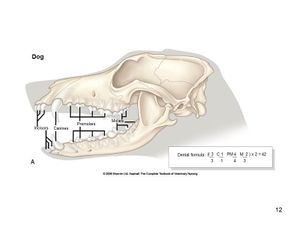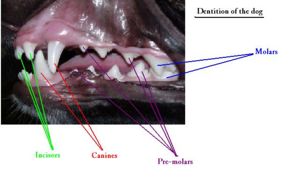Dental Formula - Dog
Overview

Dogs are toothless at birth. Their deciduous teeth are complete and functional within 2 months of birth in most breeds. Permanent teeth are complete and funtional by the end of the 7th month.
The formula for deciduous teeth: 2 (i3/3 c1/1 p3/3)
The formula for permanent teeth: 2 (I3/3 C1/1 P4/4 M2/3)
Canine teeth
The canine teeth are large, curved and laterally compressed. Their root is longer than their crown. They have a single root.
Molars
The molars are broader than the premolars. The large flat surface is used for grinding.
Incisors
The incisors are tricuspid in the upper jaw and bicuspid in lower jaw. They have a single root.
Premolars
The premolars are irregular and closely-spaced. They are more complex and larger caudally.
Breed Differences
Eruption times differ between breeds so it is difficult to age dogs by their teeth. Brachiocephalic dogs do not possess all of the cheek teeth. They have fused roots and carnasial teeth (upper P4 and lower M1).
Error in widget FBRecommend: unable to write file /var/www/wikivet.net/extensions/Widgets/compiled_templates/wrt66367f9045e550_36520057 Error in widget google+: unable to write file /var/www/wikivet.net/extensions/Widgets/compiled_templates/wrt66367f90549e77_80582387 Error in widget TwitterTweet: unable to write file /var/www/wikivet.net/extensions/Widgets/compiled_templates/wrt66367f905bfaf3_94450449
|
| WikiVet® Introduction - Help WikiVet - Report a Problem |
